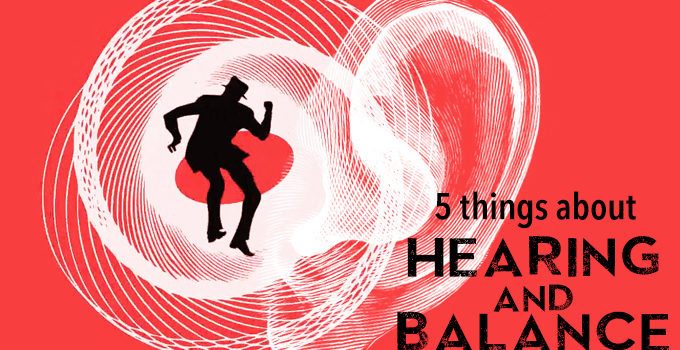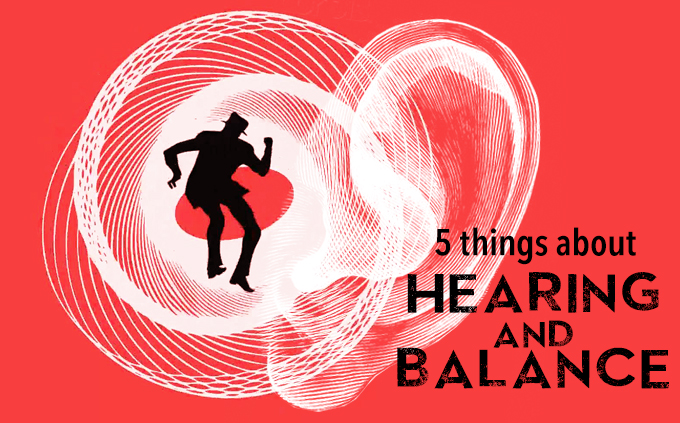

5 Things About Hearing and Balance
by Zara Jethani
Have you ever experienced a passing dizziness where you felt like you lost your balance for a moment?
While it is fairly common to have a fleeting dizzy spell, experts estimate that in the course of their lifetime, about four in ten people visit a doctor because of a significant episode of dizziness. This loss of balance could mean a sensation of floating, spinning or even faintness, which are all associated with the inner ear.
What causes balance disorders?
Dizziness is a sensation of lightheadedness, faintness, or unsteadiness. Vertigo has a rotational, spinning component, and is the perception of movement, either of the self or surrounding objects. Disequilibrium refers to unsteadiness, imbalance, or loss of equilibrium that is often accompanied by spatial disorientation. The feeling of disequilibrium without the spinning sensation is sometimes related to the inner ear while vertigo is frequently due to an inner ear disorder.
Our balance is maintained by input from vision, nerves of the muscles and joints, and the vestibular system (inner ear) which is processed into meaningful information by the central vestibular system (brainstem). Our bodies are able to compensate for variances in vision or nerve input, however abnormalities in the inner ear are more difficult to process resulting in the sensations of dizziness, vertigo or disequilibrium.
How does the ear affect balance?
The inner ear is composed of two parts: the cochlea for hearing and the vestibular system for balance. The vestibular system is made up of a network of looped tubes, three in each ear, called the semicircular canals. They loop off a central area called the vestibule.
The vestibular system detects movement through special sensory cells which are activated as you tilt or move your head. The vestibular system is very sensitive to small movements of the head. If you make large, fast or prolonged movements (eg, spinning around on the spot) they can take a while to ‘settle down’ afterwards. This is why the room can appear to continue to spin when we stop spinning. The vestibular system sends signals to the vestibular nerve, which joins the cochlear nerve and carries electrical signals to the brain.
Are balance disorders related to hearing loss?

There are many causes of hearing loss. In general, hearing loss is considered a natural part of the aging process and can develop independently or in combination with other systems in the body. Balance disorders occur because of issues in the inner ear. Depending on the underlying cause, these two could be related or could occur separate from one another.
How can balance disorders be diagnosed?

Balance disorders are evaluated with audiologic testing, videonystagmography (VNG) and often magnetic resonance imaging (MRI). VNG examines a special type of eye movement called nystagmus. Nystagmus occurs when the brain attempts to determine the position of the body when it receives conflicting messages from the ears. Nystagmus lets the examiner know the position at which the patient is dizzy. However, nystagmus is not always position-related and not all causes of dizziness result in nystagmus.
There are 4 main parts of the VNG:
Occular mobility
The patient watches steady and moving dots on a wall.
Rotational chair
The patient’s chair rotates slowly to stimulate the inner ears.
Positional nystagmus
The patient’s head and body are moved into different positions to determine if this causes nystagmus.
Caloric testing
Air or water is instilled into the ear canal at different temperatures to stimulate the inner ear. This determines if one ear reacts differently indicating an inner ear weakness.
What are some conditions of balance disorders?
There are many different balance disorders. A few of the most common are described here:
Benign Paroxysmal Positional Vertigo
Benign Paroxysmal Positional is a mechanical problem in the inner ear. It occurs when some of the calcium carbonate becomes dislodged and migrates into one or more of the three fluid-filled semicircular canals. These crystals interfere with the normal fluid movement that these canals use to sense head motion, causing the inner ear to send false signals to the brain. This causes brief but severe spinning sensations with movement. Treatment is with repositioning maneuvers.
Meniere’s Disease
Meniere’s Disease causes attacks of vertigo, hearing loss, tinnitus and ear fullness. It is caused by an increased pressure of an abnormally large amount of endolymph in the inner ear and/or from the presence of potassium in an area of the inner ear where it doesn’t belong. While there is no cure, treatments are for the treatment of vertigo and can include medicine, inner ear injections or surgery.
Vestibular neuronitis
Vestibular neuronitis results from an infection that inflames the inner ear or the nerves connecting the inner ear to the brain. This inflammation disrupts the transmission of sensory information from the ear to the brain. Vertigo, dizziness, and difficulties with balance. Infections of the inner ear are usually viral. Such inner ear infections are not the same as middle ear infections, which are the type of bacterial infections common in childhood affecting the area around the eardrum. Treatment uses medication for nausea and dizziness.
Age-related dizziness and imbalance
Age-related dizziness and imbalance is typically multifactorial related to weaker muscles, decreased visual acuity and failing vestibular systems. After ruling out other causes a vast majority of patients improve with vestibular rehab.
Migraine-associated vertigo
Migraine-associated vertigo occurs in approximately 40% of migraine patients. It involves disruption in their balance and/or dizziness at one time or another. This may be prior to, during, after, or totally independent of their migraine event. Diet modifications and certain medications used in migraine management may ameliorate or prevent the vestibular component of the migraine.
Clinics
PNI-Wilshire: 310-477-5558
PNI-Santa Monica 2125 Arizona : 310-829-8701
PNI-Santa Monica 1301 20th #300: 310-829-7792
PNI-South Bay Torrance: 424-212-5361
Useful Links
Hearing & Balance at Pacific Eye, Ear & Skull Base Center
Read More from Pacific Eye, Ear & Skull Base Center
About the Author

Zara Jethani
Zara is the marketing director at Pacific Neuroscience Institute. Her background is in molecular genetics research and healthcare marketing. In addition, she is a graphic designer with more than 20 years experience in the healthcare, education and entertainment industries.
Last updated: January 11th, 2023









